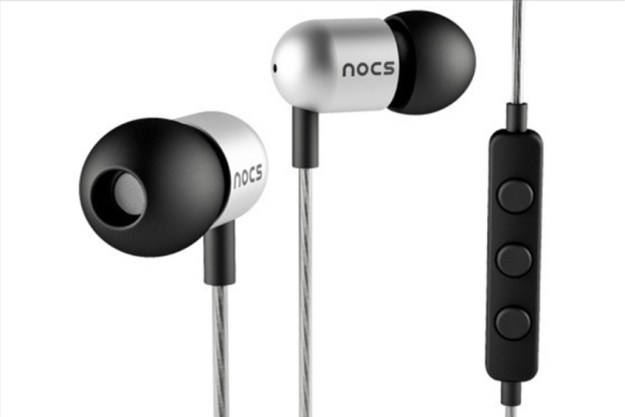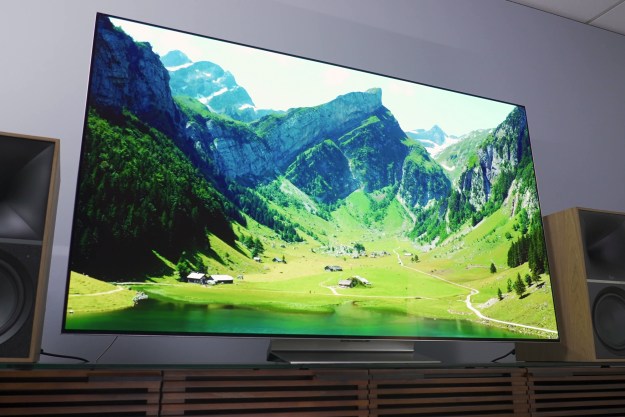
“Those who are sensitive to treble, or simply prefer a “darker” headphone should probably consider something else. But for those who like bright and brilliant response, the NS600 make for a comfortable and attractive option.”
- Big, deep bass from a compact in-ear
- Clear, uncongested midrange
- Comfortable fit
- Aggressive, sometimes shrill treble
- Non-pliable cord
Take a look at just about any headphone product line, and you’re likely to find a wide range of models, easily differentiated by design points and features. But things get a little fuzzier with the Swedish headphone maker, Nocs.
Nocs’ line of in-ear headphones, model to model, will look very similar to most onlookers. Aside from some small differences in color and a moderate range in price, the NS200, NS400, NS600 and NS800 look almost identical. You have to read deep into the technical specifications to understand what makes each model special and, even then, it is difficult for most folks to translate all those specs into something meaningful. But, if you listen to them, the sonic differences that define each of Nocs’ in-ear headphones leap out.
While many manufacturers claim sound quality is the guiding principle behind their designs, we have found that claim is rarely borne out in the products cloaked in this marketing blather. Nocs is one of the few exceptions. The sound characteristics of its NS400 Titanium and NS800 Monitor in-ear headphones were markedly different, yet each maintained a standard of excellence, while targeting a different sort of discerning listener. We were curious to find out how the NS600 Crush would fit within Nocs’ line-up. Having now spent a good month with the NS600, we’ve got it figured out. Read on for our impressions.
Out of the box
Nocs has a thing for simplicity when it comes to packaging. Fortunately, however, its tendency toward minimalism doesn’t bleed into areas where performance and use are concerned. In the NS600’s simple box, we found two pair of three different sizes of silicone ear tips, an airline adapter, a clip, and a suede storage pouch that is small enough to stuff in your pocket, but large enough to hold everything that comes in the box.
Features and design
The NS600 Crush are similar in size to the NS400, but substantially lighter, thanks to a sandblasted-aluminum housing. The cable, which is said to be made of a blend of Kevlar, copper and Thermoplastic Elastomers (TPE) has a rubbery, anti-skid feel to it. It’s a good thing we can’t find any instance of Nocs referring to the cable as tangle-resistant, because it most certainly is not. After coiling the cable a few times to fit the earphones in their case, we noticed it wanted to stay coiled – a slight annoyance if you need to use the whole length of it.
Nocs has outfitted the NS600 with an in-line, three-button, iOS-compatible microphone, which is placed much closer to the ear than most competing designs. We like that microphone is placed close enough to the mouth that lifting it up to speak is unnecessary, but it takes time to get used to reaching that far up to get at the controls.

The NS600’s most important feature is its dual-dynamic-driver design. Rather than use a single driver as most in-ears do, the NS600 has two. Think of it as being similar to a two-way speaker, with a tweeter and a woofer for each ear. Interestingly, both drivers are big enough to be used on their own. The smaller of the two is a 5.78mm, Titanium-coated diaphragm while the larger is an 8.0mm dual-magnet driver. The larger of the two handles the bass while the smaller of the two handles midrange and treble. The advantage of such a design can be higher sensitivity, lower distortion, better dynamics and superior clarity.
Like the NS400, the NS600 sport a tiny, pin-sized port to help facilitate airflow in and out of the earphones’ housing, presumably aiding bass response.
Burn-in
We found the NS600 didn’t benefit as much from a lengthy break-in period as, say, the NS800 did. We did feel like bass response beefed up a bit after about 40 hours of use, but we didn’t experience a dramatic change in the NS600’s sonic signature. All this to say that what you get out-of-box is a pretty good representation of what you’ll be getting after several months of average use.
Comfort
While the NS600 are notably lighter than the NS400 (by about 1.1 oz.), we didn’t feel as if they were any more or less comfortable. We consider both to be as non-invasive as an in-ear headphone can be. We did notice, though, that the NS600 protrude from the ear a bit more. This isn’t a big deal for most folks, save those who like to go to sleep with their earphones in; in that case, the NS600 might not be the optimal choice.

Audio performance
We still use the NS400 to this day as a reference for other in-ear headphones in the $100 category. As such, we’re very familiar with how they sound: revealing and detailed with accurate midrange, deep, musical bass, and mostly natural treble.
The NS600, by contrast, are a much bolder effort from Nocs. The company bills them as “a must-have for any traveling DJ” and while we’re not inclined to comment on whether DJs would agree, we will say that the slogan is a pretty good clue as to the direction the NS600 lean toward. You get bolder bass and extended, slightly hot high frequency response, but, unlike many “DJ-oriented” headphones we’ve tried over the years, the NS600 don’t forsake the midrange response in favor of big bass and brilliant treble.
We started out our listening session with I Gotta Feeling by the Black Eyed Peas, a tune that we readily admit we find loathsome. Still, the song starts out with a synthesized arco bass accompanied by striking layers of various synthesized instrumentation and, of course Will.i.am’s auto-tuned vocal, which serves to let us know how tuneful a given headphone’s bass response is and how well it handles sudden attacks. The NS600 handled it all very well. The long bowing of the bass was reproduced with plenty of faux-bow texture and the slapping synth sounds were clean and well separated. Later the big bass drum beat kicks in and the NS600 revealed their secret weapon: big, punchy bass.

But the NS600’s big bass response managed to keep from dominating the rest of the frequency spectrum. Will.i.am’s vocal was reproduced with enough clarity that, at times, it sounded as if we were listening to a dry mix directly off a recording console’s output – a tough trick to pull off.
The NS600’s high-frequency response is equally brazen, but, unlike the bold bass (which we enjoyed during almost our entire evaluation period) we had a tough time embracing the treble at times. There’s this unnaturally hot, almost metallic approach to the high frequencies that simply doesn’t suit our tastes. For example, when listening to Earth, Wind and Fire’s Let’s Groove, we found the ride cymbal had a piercing quality to it that, while not intolerable, isn’t indicative of the recording. The cymbals in that tune simply aren’t that crispy. And when we played Will Smith’s Just the Two of Us – a notoriously bright recording – the cymbals were too much to handle for more than just a few seconds.
On the other hand, the NS600’s rather unnatural brilliance lent some much needed zeal to otherwise dark recordings such as Michael McDonald’s I Keep Forgetting and the Brecker Brothers’ Don’t Stop the Music. Additionally, we found that the NS600 sounded particularly well-suited to playing back vinyl records, though such a scenario is hardly practical.
Conclusion
Nocs’ calculated approach to design is smart. We appreciate that the company has managed to maintain sonic excellence, while developing products with distinct character that will suit a wide range of tastes. The NS600 won’t replace the NS400 or even the NS800 in our bag of reference in-ear headphones, but we can see how they will be a solid fit for some tastes. Were it not for what we feel is artificially aggressive treble response, we could more easily appreciate the NS600’s bold bass and clear midrange attributes. Those who are sensitive to treble, or simply prefer a “darker” headphone should probably consider something else. But for those who like bright and brilliant response, the NS600 make for a comfortable and attractive option.
Highs
- Big, deep bass from a compact in-ear
- Clear, uncongested midrange
- Comfortable fit
Lows
- Aggressive, sometimes shrill treble
- Non-pliable cord




